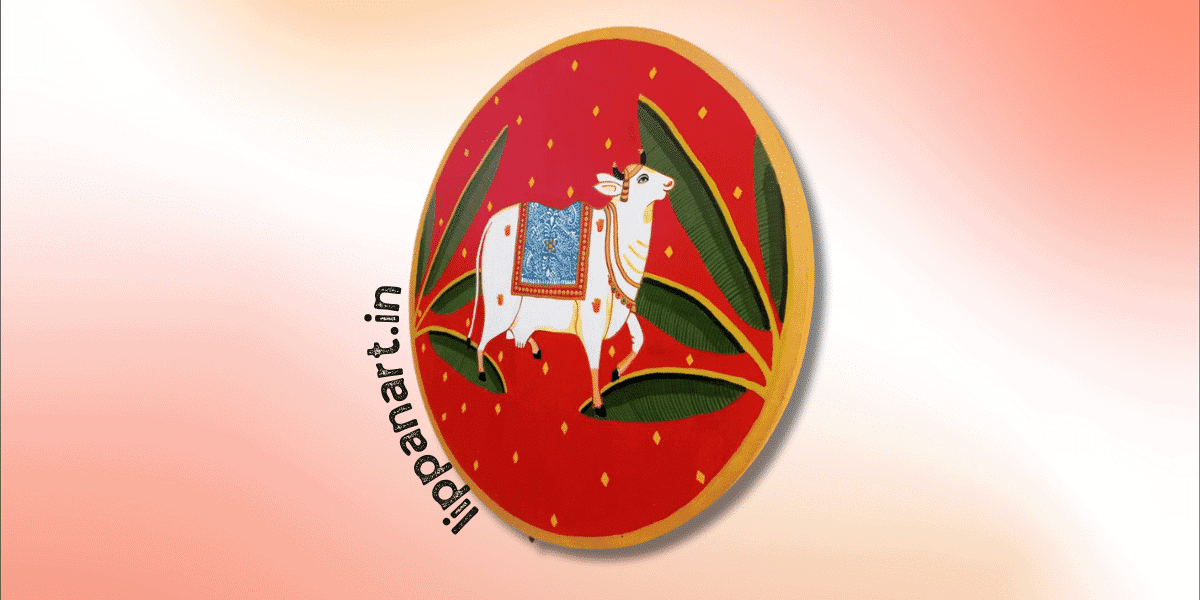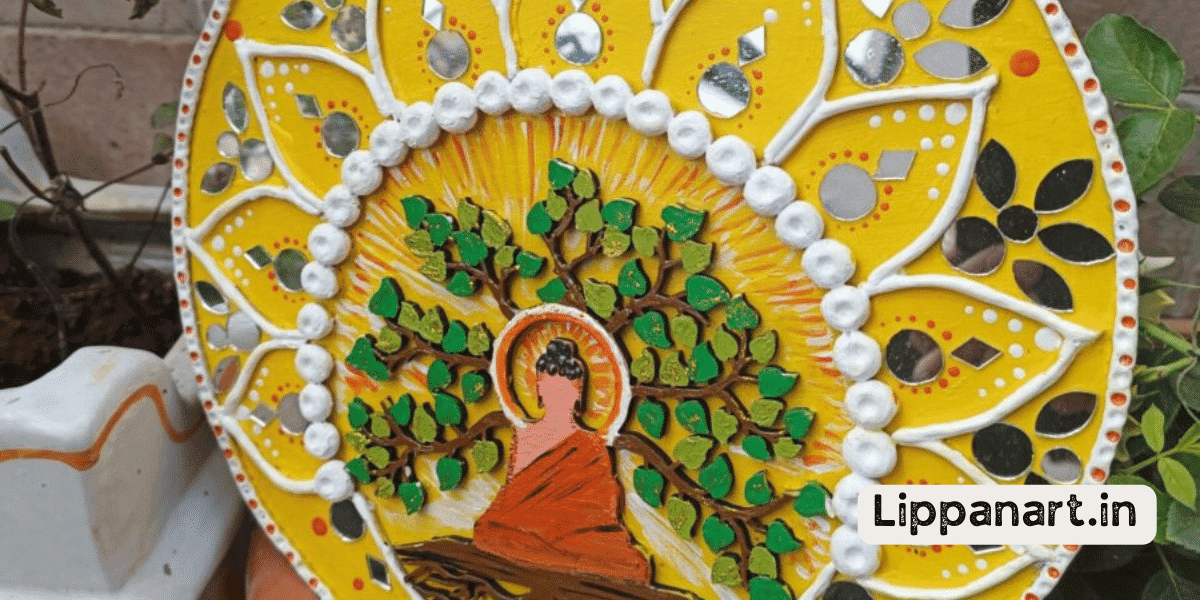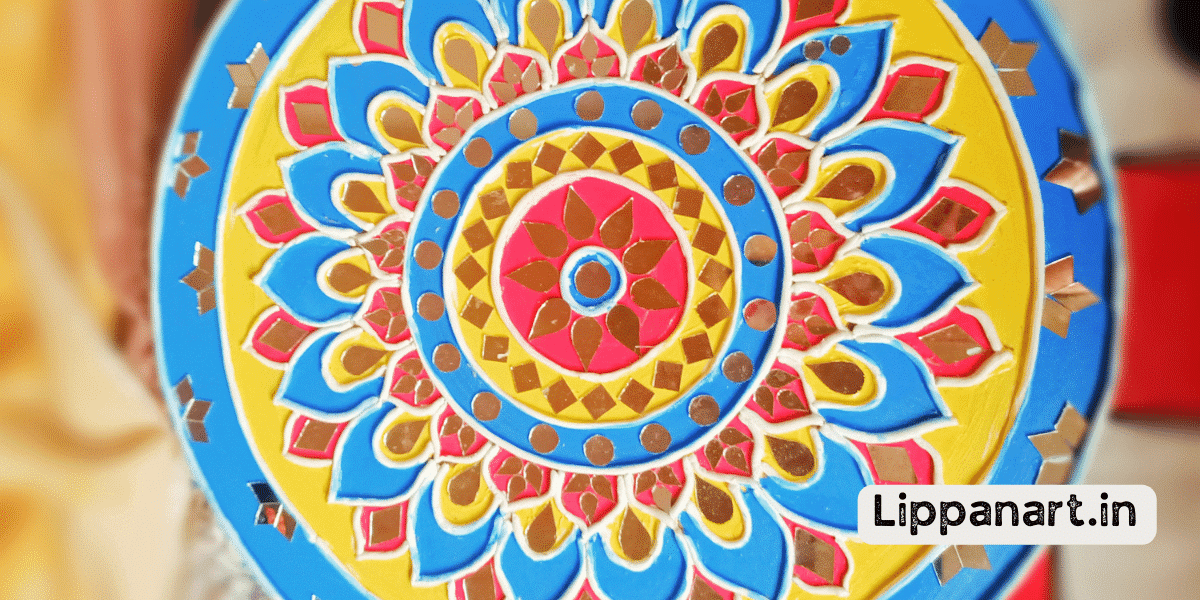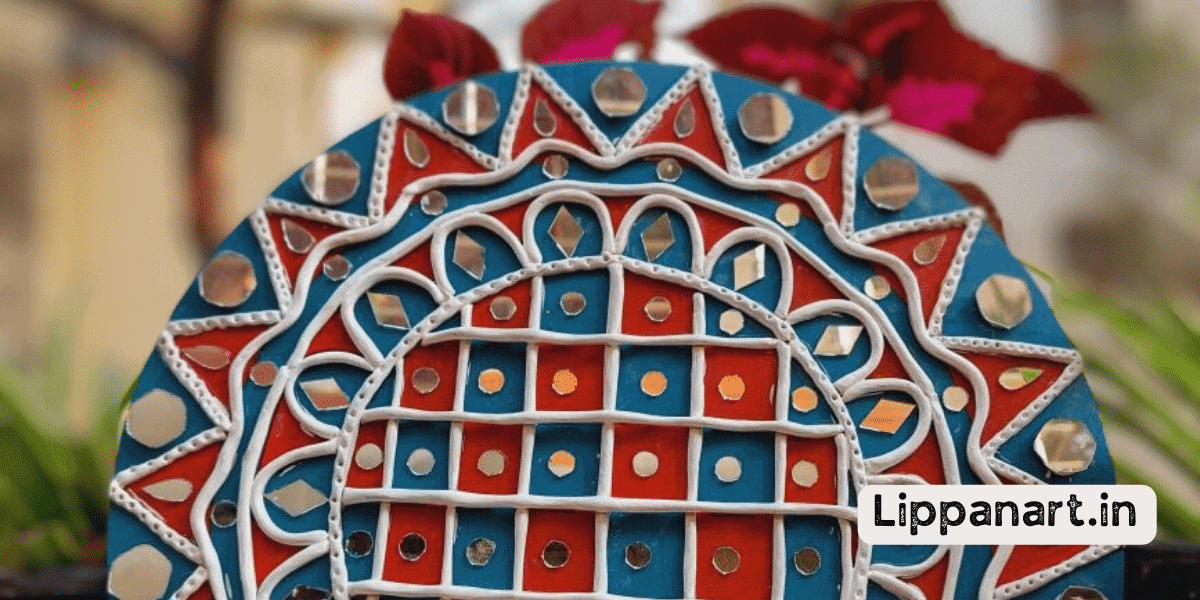Imagine the beauty of intricate lippan art animals, each one carrying cultural and symbolic significance. Marvel at the majestic peacock, the strong and majestic elephant, the resilient camel, the nurturing cow, the chirping birds, the powerful lions and tigers, the mysterious snakes, and the majestic horses.
With each animal conveying a unique message, let the lippan art take you on a journey of exploration and discovery.
Key Takeaways
- Peacock is a prominent animal in Lippan Art, representing love, fertility, and prosperity in Hindu and Jain culture.
- Elephant holds cultural significance in Lippan Art, symbolizing strength, courage, power, wisdom, and fertility, and is associated with the god Ganesha.
- Camel represents long journeys, stability, and resilience in Lippan Art, crafted using small pieces of cloth, shells, beads, and mirrors.
- The cow is associated with divine origin, fertility, abundance, wealth, and divine protection in Lippan Art, expressing spiritual significance through intricate geometric patterns.
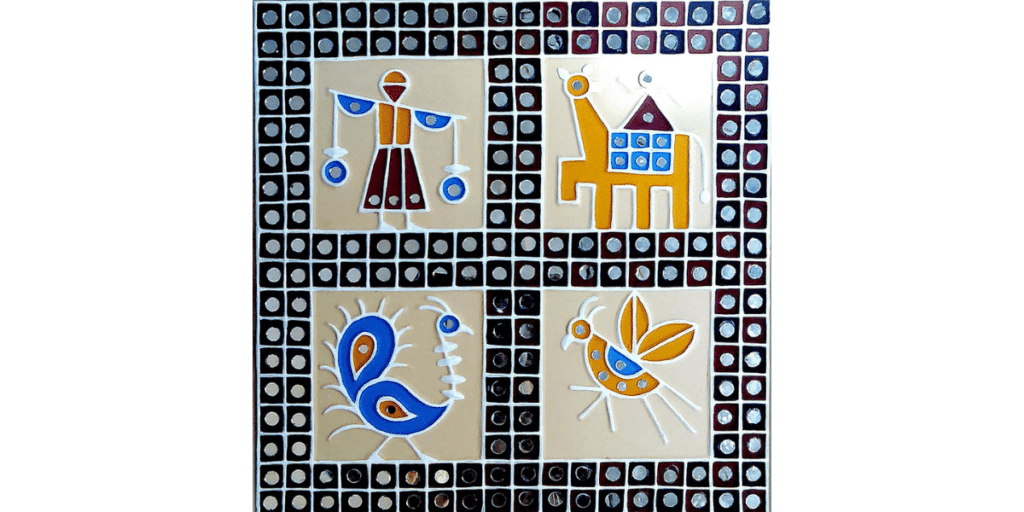
Peacock
The peacock is one of the most recognizable symbols of India due to its cultural and symbolic significance. It’s a popular subject in Lippan art, a traditional form of art from Gujarat.
The Gendered Representations of peacocks in Lippan art are often seen as symbols of love, fertility, and prosperity in Hindu and Jain culture.
The Intergenerational Transmission of this art form has allowed its Indigenous significance to be treasured and passed down through generations.
In addition to its Social Significance in Indian culture, the Material Variations of Lippan art peacocks add to their charm. The materials used to produce a peacock range from paper, wood, and mirrors to fabric, mud, and even camel dung!
These unique materials help to capture the beauty of the peacock in a truly innovative way.
Elephant
Following closely behind the peacock in Indian culture is the elephant, a symbol of strength, power, and wisdom. Elephants can be seen in many different forms of art, with diverse uses and symbolism.
Here are some of the ways elephants are perceived in Indian culture:
- Diverse Uses of Elephant Art: Elephant art can be used as decoration, a storyteller, or a reminder of important life lessons.
- Elephant as a Symbol of Strength: Elephants signify strength, courage, and power in India. They’re often used as a symbol of protection and good luck.
- Elephants in Religious Traditions: Elephants are often associated with the god Ganesha. They’re also used to represent wisdom and fertility.
- Elephants in Popular Culture: Elephants are often used in Indian films and literature to represent strength and wisdom. They’re also used as a symbol of loyalty and friendship.
- How Elephants are Perceived: Elephants are seen as wise, powerful, and strong. They’re a reminder of the importance of having faith and strength in difficult times.
- Editor’s Choice
- Best Seller
- Amazon Choice
Camel
You may not think of a camel when it comes to Lippan art, but it’s an animal with strong symbolism and cultural significance. From sustainable practices to the importance of folklore, this unassuming creature is deeply woven into the fabric of the craft.
Crafting techniques often involve the use of small pieces of cloth, shells, beads, and mirrors to create intricate designs that represent the animal. Artistic styles range from abstract to figurative, and the symbolism of a camel often reflects the local culture. From the long journeys it has taken traders on in the past to its association with stability and resilience, the camel has a powerful place in the traditional art form. Though its presence may be subtle, its significance is undeniable.
To truly appreciate the symbolism of a camel in Lippan art, it’s important to understand the sustainable practices, folklore importance, crafting techniques, artistic styles, and local symbolism that are associated with this iconic animal.
Cow
With its proud stature and gentle demeanour, the cow is another animal with a deep history in Lippan art. From learning traditional meanings to exploring spiritual symbolism, from comparing regional art styles to evaluating conservation efforts, from examining craftsmanship techniques to exploring the spiritual symbolism of cows, the art form is rich with possibilities.
The cow is a popular subject in Lippan art, often depicted with a halo of seven stars, which symbolizes its divine origin and connection to the divine. The cow is also associated with fertility, abundance, and wealth, and in some cultures, it is seen as a divine protector.
The traditional art of Lippan is a form of storytelling, with each piece conveying a unique message. The artwork’s intricate geometric patterns express a profound understanding of cows’ spiritual significance.
In addition to its spiritual symbolism, the cow is also celebrated for its beauty and grace. By exploring traditional art styles, one can gain a deeper appreciation for the craftsmanship and skill of the Lippan artisans.
The conservation of the art form is essential, and the efforts of local artisans to preserve and promote the craft are commendable. The appreciation of the cow in Lippan art is an important part of traditional culture and reflects a deep sense of reverence and respect for the animal.
From its spiritual symbolism to its representation in art, the cow is an important part of the Lippan tradition. By learning traditional meanings, exploring spiritual symbolism, comparing regional art styles, evaluating conservation efforts, and examining craftsmanship techniques, one can gain a deep understanding and appreciation of this majestic animal in Lippan art.
- Editor’s Choice
- Best Seller
- Amazon Choice
Birds
Frequently, birds appear in Lippan art, symbolizing many different things. Exploring this folklore offers an opportunity to understand its symbolism in traditional artistry. Depending on the region, these birds may take on various cultural relevance and meanings, and this can be seen in the regional variations. They often symbolize freedom, a connection to the divine, and even a sign of good luck. Additionally, birds can represent fertility, protection, and even new beginnings.
By looking closely at the artwork, one can gain insight into the symbolism and the cultural relevance of the art.
In some cases, the birds may be a representation of a god or goddess, such as the Garuda, the mythical bird of Hindu mythology, or the Phoenix, which is a symbol of transformation. Other times, they may be used to represent a certain emotion, such as joy or sorrow. By studying the art and the symbolism of the birds, one can gain a better understanding of the cultural context and the traditional artistry of Lippan art.
Fish
Fish are a common subject of Lippan art, often signifying various meanings. Using colours, symbolism, history, myths, religions, forms, textures, etc., the artistry of Fish can create a vivid story for those who take the time to observe it. Fish patterns, shapes, and colours can all be used to convey a deeper message:
- Fish patterns can tell tales of ancient cultures, religions, and myths.
- Fish artistry can reflect a person’s beliefs and values.
- Fish symbolism, when used in conjunction with colours and shapes, can create powerful messages of hope and peace.
In short, Fish art isn’t just about beauty and aesthetics. It’s about conveying a deep and meaningful message that can be understood by all who view it. With its unique forms, textures, and colours, Fish art can be used to tell stories, communicate ideas, and even honour the dead. When done right, Fish art can be a powerful and beautiful way to express oneself.
- Editor’s Choice
- Best Seller
- Amazon Choice
Peacock
Similar to Fish, Peacocks are also a common subject of Lippan art, often signifying a variety of meanings. Crafted with care and imagination, these beautiful animals have a special place in the hearts of many. Their colourful imagery makes them an ideal canvas for creating meaningful art.
The cultural interpretations of peacocks vary depending on the region, but they’re often associated with spiritual significance. The historical origins of these animals can be traced back to India, where they’re seen as symbols of beauty, grace, and nobility. Peacock Lippan art is highly sought after and is often used to represent the cycle of life, prosperity, and fertility.
The intricate details and vibrant colours of these pieces help to bring out the spiritual and cultural significance of the animal. Peacock Lippan art is a great way to express your creativity and also make a statement about your beliefs. By exploring the symbolism and history behind peacock art, you can create beautiful and meaningful pieces that speak to your values.
Lions and Tigers
Building on the symbolism associated with Peacocks, Lions and Tigers are also popular subjects of Lippan art due to their powerful representation of strength and courage. Exploring their symbolic meanings, these majestic animals are used to represent the cultural and spiritual significance of India. Crafted with meticulous detail, their artistic expression and craftsmanship techniques make them a captivating addition to any home.
- Cultural Representation: Lions and tigers are seen as symbols of power, courage, and strength, which make them an ideal representation of Indian culture.
- Spiritual Significance: For centuries, these animals have been associated with spiritual guidance and enlightenment, making them an important symbol in Hinduism.
- Artistic Expression: Lippan art is a creative and unique art form, and these majestic animals are a perfect way to express one’s artistic vision.
Lippan art is an intricate and captivating medium, and Lions and Tigers are a perfect addition to any home. With their strong symbolic meanings and cultural representation, they’re a timeless and iconic representation of Indian culture and spirituality.
- Editor’s Choice
- Best Seller
- Amazon Choice
Snakes
Like Lions and Tigers, Snakes are also a popular subject of Lippan art due to their powerful representation of strength and courage. Beyond this, they can carry deeper spiritual meaning, with many cultures and regions incorporating them into their beliefs and customs. Snakes are often seen as medicine, with their skin and scales traditionally used to treat a variety of ailments. Regional styles of Lippan art featuring snakes vary significantly, with some being associated with gender roles and others used to express spiritual symbolism.
Modern interpretations of Lippan art featuring snakes often incorporate traditional motifs but with a contemporary edge. These works can explore the relationship between humans and nature, as well as the healing power of the serpent. They can also be used to explore the complexity of gender roles and the power of the feminine. Whatever the interpretation, Lippan art featuring snakes is sure to captivate and intrigue, offering viewers an insight into the culture and symbolism of these powerful creatures.
Horses
You’ve likely seen horses featured in Lippan art, representing strength and courage with their powerful stance and graceful movements. Exploring their cultural significance reveals a rich history of representation in ancient art, historic preservation, and modern representation.
Representation in Ancient Art: Horses have been featured in art for centuries, from Ancient Greece to India to Africa.
Historic Preservation: Lippan art helps to preserve traditional cultural practices and symbols in a modern context.
Craft Techniques: The craft techniques used in creating Lippan art are intricate and often require a high level of skill and experience.
Horses have been a source of inspiration in Lippan art, symbolically representing power, courage, and strength. Today, contemporary representations of the horse in Lippan art continue to explore the cultural significance of the animal. Through their craft techniques, artisans are able to create beautiful works that evoke feelings of pride in their culture and heritage.
Conclusion
You’ve been on a wild ride through India’s history and culture with the lippan art animals!
From the majestic peacock to the powerful lion and tiger, from the humble cow to the wise elephant, from the graceful horses to the mystical snake, you’ve seen it all!
Each animal has its own unique story and symbolism that will stay with you forever.
You’ve truly been mesmerized by the beauty and power of these animals!
